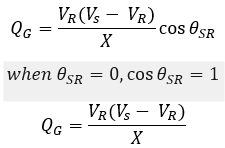A synchronous condenser is a synchronous machine that runs without a mechanical load and is used to provide reactive power support to large electrical networks. By varying the field current, synchronous condensers can provide fast and continuously adjustable reactive power injection or absorption capability. Synchronous condensers also improve the short-circuit strength of the connected grid. Fast reactive power support is crucial for providing voltage support, voltage stability, and power factor improvement in large, interconnected networks. Synchronous condensers are commonly used in power transmission systems and in large industrial plants and are often, but not always, connected to the tertiary winding of power transformers.
Read: Power flow and voltage stability on AC transmission lines

Lack of sufficient reactive power in the grid can lead to voltage collapse and power system instability, while excess reactive power in the grid can lead to voltage rise. To maintain voltage stability, utilities traditionally use capacitor banks. Capacitor banks provide steady-state reactive power injection to the grid. However, these banks are slow to react to any sudden increase or decrease of reactive power demand. An exception to this is static switched capacitor banks, and even then, the fineness and preciseness of reactive power injection cannot be achieved unless a large number of capacitor steps are used. In contrast to fixed capacitor banks, synchronous condensers offer fast reactive power injection, the magnitude of which can be precisely controlled by adjusting the field current of the synchronous machine.

Terminal voltage drop will cause increased reactive kvar from synchronous condensers in contrast to capacitor banks, which deliver reduced reactive kvar (capacitive kvar varies in direct proportion to the square of terminal voltage). Synchronous condensers can often supply up to two times the rated kvar for up to 10s. Thus, a synchronous condenser has a stabilizing effect on the grid when it is most needed.
Link to: Power factor calculator
Consider a synchronous machine with terminal voltage of VS connected to a bus with voltage VR. Real power delivered by this machine to the bus is given by:

Depending on the angle θSR, real power delivered, and performance of the machine is as follows:

Read: Surge impedance loading of transmission line
When a synchronous machine is operating in an unloaded condition (θSR=0), the real power delivered is zero. However, the interesting part is that under this condition the machine can supply reactive power.

Thus, when the generator is unloaded and when terminal voltage VS is greater than bus voltage VR, the synchronous generator is supplying reactive power. A synchronous generator specifically built to supply reactive power is known as a synchronous condenser. Observing the reactive power equation, it can be seen that by adjusting the machine terminal voltage (VS) relative to bus voltage (VR), a synchronous condenser can supply or absorb reactive power from the grid. To supply for machine losses, the condenser will draw a small amount of real power from the connected grid.
Standard synchronous condensers can supply reactive power equal to their rating and absorb half their rated capacity. For example, machine ratings are typically provided as +25/-12.5 MVAr, which means this machine can supply +25 MVAr or absorb -12.5 MVAr of reactive power. Since a synchronous condenser can release and absorb reactive power, it may be considered a combination of a capacitor bank connected to a shunt reactor.
Read: Charging current in high-voltage cable
Wind and solar farms typically have low reactive generation capacity and low short circuit strength. Synchronous condensers, when used in such locations, provide reactive power support, voltage stability, and improved short circuit strength. At the tail end of long unloaded transmission lines or long unloaded HV cables, excess capacitive kvar released can cause tail end voltage to rise. Synchronous condensers can be used in such cases to absorb excess reactive power from the unloaded line.
Read: Overcompensation of reactive power for induction motors
Typical synchronous condensers are modular in nature and have available ratings from 10 MVAr to 150 MVAr per machine. Multiple machines are usually stacked in operation to supply the required MVAr. A combination of fixed capacitors and synchronous condensers is often the most economical choice for reactive power support.
Comparison of Synchronous Condenser Vs. Capacitor Bank
| Characteristics | Synchronous Condenser | Capacitor Bank |
| Typical MVAr rating | 10-150 MVAr per machine | Very wide range of possibilities |
| Cost | Cost more for a given MVAr size compared to capacitor banks | Cost less than comparable synchronous condensers |
| Reactive Power- Capacitive | Capable of providing capacitve Vars up to rated MVAr | Same |
| Reactive Power- Inductive | Capable of absorbing inductive Vars up to 50% of rated MVAr | Not capable of absorbing inductive Vars |
| Overload capacity | Capable of overloading up to designated value by the manufacturer | No overload capacity |
| Fine control | Capable of very fine control by varying field current | Number of capacitor steps determine the fine control capability |
| Bus voltage variation | Reduction of bus voltage increases the kVAr supplied and hence condenser has a stabilizing effect on the grid | Reduction of bus voltage decreases the kVAr supplied, which can negatively affect grid stability |
| Flexibility | Less flexible as synchronous condensers are installed in large, centralized locations. Adding more capacity is not easy. | More flexible as capacitor banks can be located throughout the grid and closer to load. Additional capacitors can be added easily |
| Short circuit strength | Synchronous condensers add short-circuit strength to the grid. This is advantageous in weak grids | Capacitor banks do not add short circuit strength to grid |
| Losses | Non-negligible losses in both loaded and unloaded condition | Significantly less losses in capacitor bank |
| Reliability | Synchronous condesers are considered very reliable if maintained properly | Fuse blowing on capacitor bank reduces Var output and could go unnoticed |
| Maintenance | Maintenance required | Very little to no maintenance required |
